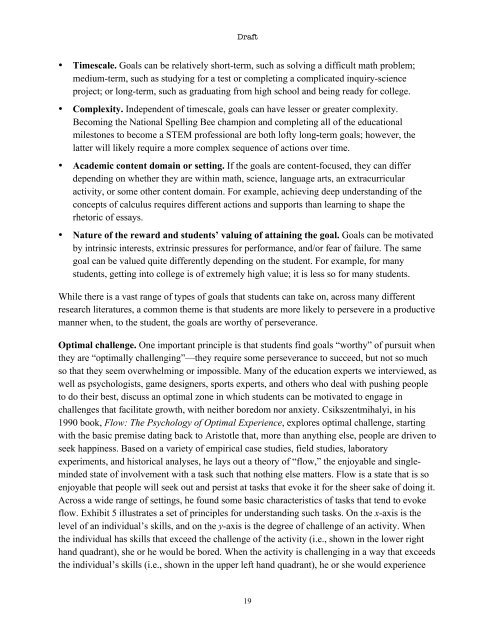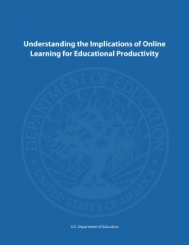Promoting Grit, Tenacity, and Perseverance - U.S. Department of ...
Promoting Grit, Tenacity, and Perseverance - U.S. Department of ...
Promoting Grit, Tenacity, and Perseverance - U.S. Department of ...
Create successful ePaper yourself
Turn your PDF publications into a flip-book with our unique Google optimized e-Paper software.
Draft<br />
• Timescale. Goals can be relatively short-term, such as solving a difficult math problem;<br />
medium-term, such as studying for a test or completing a complicated inquiry-science<br />
project; or long-term, such as graduating from high school <strong>and</strong> being ready for college.<br />
• Complexity. Independent <strong>of</strong> timescale, goals can have lesser or greater complexity.<br />
Becoming the National Spelling Bee champion <strong>and</strong> completing all <strong>of</strong> the educational<br />
milestones to become a STEM pr<strong>of</strong>essional are both l<strong>of</strong>ty long-term goals; however, the<br />
latter will likely require a more complex sequence <strong>of</strong> actions over time.<br />
• Academic content domain or setting. If the goals are content-focused, they can differ<br />
depending on whether they are within math, science, language arts, an extracurricular<br />
activity, or some other content domain. For example, achieving deep underst<strong>and</strong>ing <strong>of</strong> the<br />
concepts <strong>of</strong> calculus requires different actions <strong>and</strong> supports than learning to shape the<br />
rhetoric <strong>of</strong> essays.<br />
• Nature <strong>of</strong> the reward <strong>and</strong> students’ valuing <strong>of</strong> attaining the goal. Goals can be motivated<br />
by intrinsic interests, extrinsic pressures for performance, <strong>and</strong>/or fear <strong>of</strong> failure. The same<br />
goal can be valued quite differently depending on the student. For example, for many<br />
students, getting into college is <strong>of</strong> extremely high value; it is less so for many students.<br />
While there is a vast range <strong>of</strong> types <strong>of</strong> goals that students can take on, across many different<br />
research literatures, a common theme is that students are more likely to persevere in a productive<br />
manner when, to the student, the goals are worthy <strong>of</strong> perseverance.<br />
Optimal challenge. One important principle is that students find goals “worthy” <strong>of</strong> pursuit when<br />
they are “optimally challenging”—they require some perseverance to succeed, but not so much<br />
so that they seem overwhelming or impossible. Many <strong>of</strong> the education experts we interviewed, as<br />
well as psychologists, game designers, sports experts, <strong>and</strong> others who deal with pushing people<br />
to do their best, discuss an optimal zone in which students can be motivated to engage in<br />
challenges that facilitate growth, with neither boredom nor anxiety. Csikszentmihalyi, in his<br />
1990 book, Flow: The Psychology <strong>of</strong> Optimal Experience, explores optimal challenge, starting<br />
with the basic premise dating back to Aristotle that, more than anything else, people are driven to<br />
seek happiness. Based on a variety <strong>of</strong> empirical case studies, field studies, laboratory<br />
experiments, <strong>and</strong> historical analyses, he lays out a theory <strong>of</strong> “flow,” the enjoyable <strong>and</strong> singleminded<br />
state <strong>of</strong> involvement with a task such that nothing else matters. Flow is a state that is so<br />
enjoyable that people will seek out <strong>and</strong> persist at tasks that evoke it for the sheer sake <strong>of</strong> doing it.<br />
Across a wide range <strong>of</strong> settings, he found some basic characteristics <strong>of</strong> tasks that tend to evoke<br />
flow. Exhibit 5 illustrates a set <strong>of</strong> principles for underst<strong>and</strong>ing such tasks. On the x-axis is the<br />
level <strong>of</strong> an individual’s skills, <strong>and</strong> on the y-axis is the degree <strong>of</strong> challenge <strong>of</strong> an activity. When<br />
the individual has skills that exceed the challenge <strong>of</strong> the activity (i.e., shown in the lower right<br />
h<strong>and</strong> quadrant), she or he would be bored. When the activity is challenging in a way that exceeds<br />
the individual’s skills (i.e., shown in the upper left h<strong>and</strong> quadrant), he or she would experience<br />
19
















